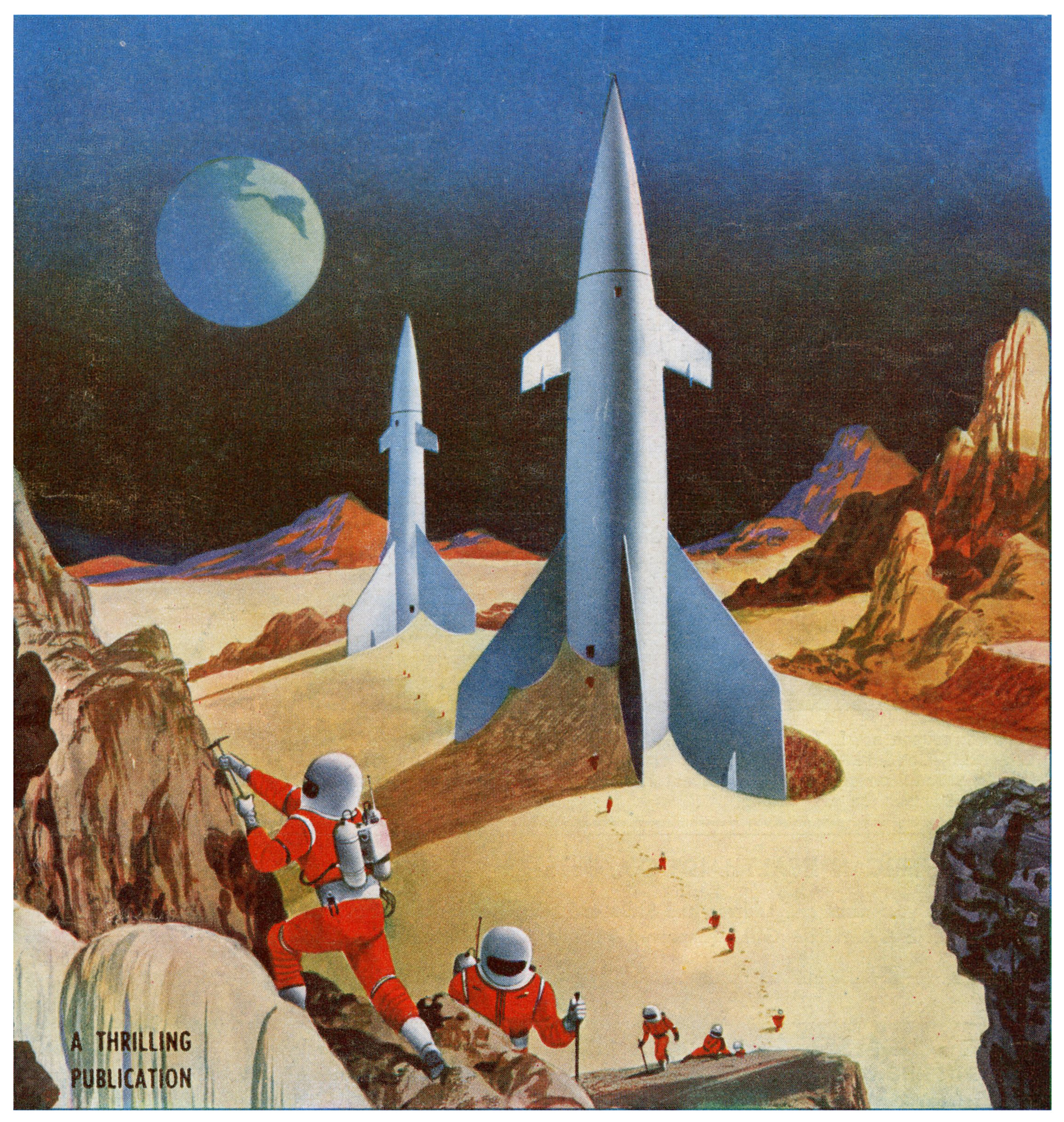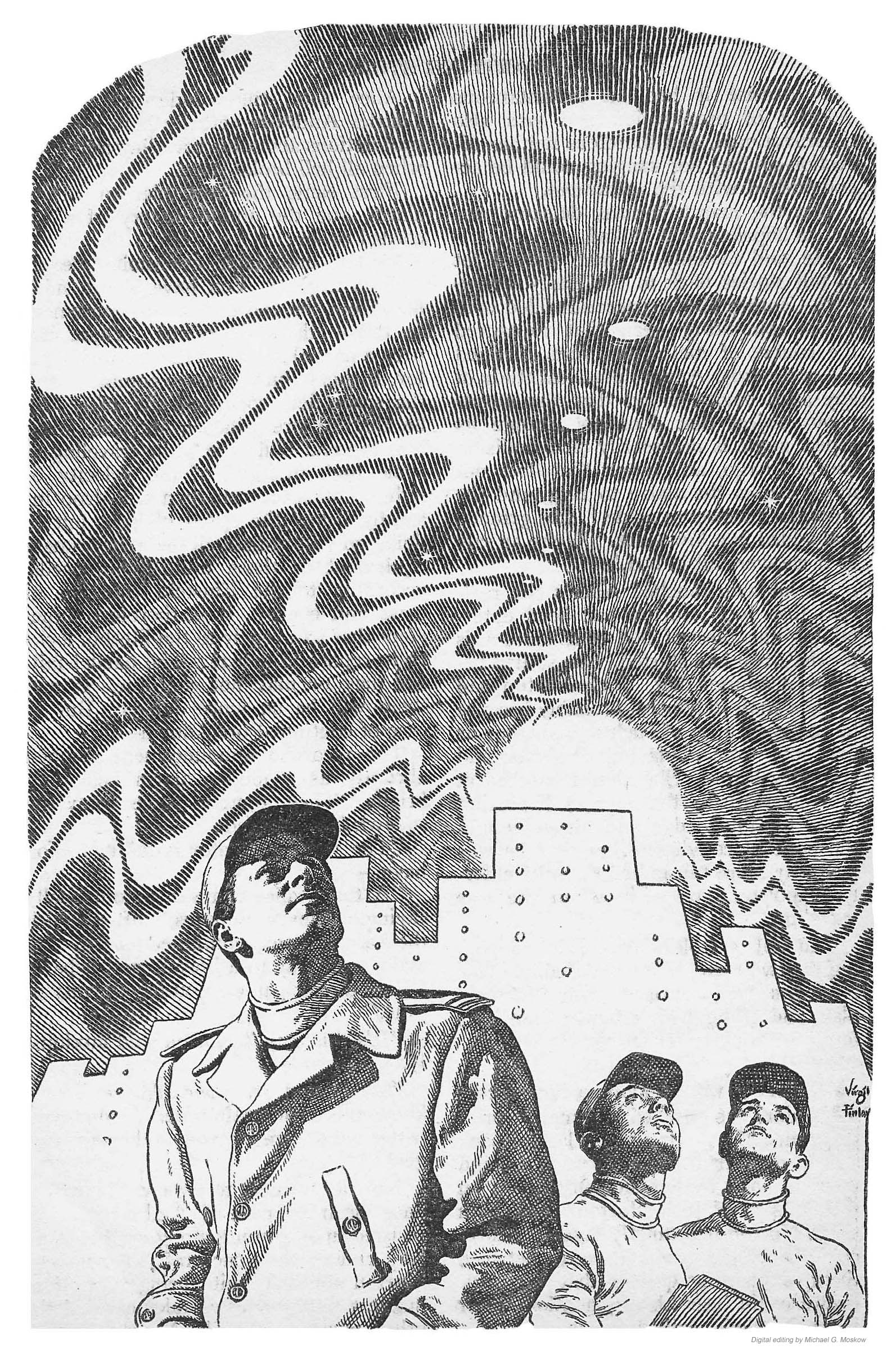This post dates back a-ways. Specifically, to February of 2018. Displaying Alex Schomburg’s cover for the October, 1954 issue of Startling Stories, as a way of indirectly leading to Virgil Finlay’s illustration for “Spacemen Lost”, the image I showed originally was simply “copy & saved” from the Internet. (It’s now shown all the way at the bottom of the post.)
Since then, I’ve been able to acquire a copy of this issue in very nice condition, with the cover featuring only one minor fold on the right edge, but no real tears or crinkles. Considering the untrimmed fragility of the cover edges of Startling Stories and similar Thrilling Publication pulps, it’s a fortunate find.
And so, the entire cover…
…and then, a cropped view of Schomburg’s art. The scene depicted bears no direct (for that matter, not even an indirect) relationship to the issue’s contents, but it’s quite appropriate, the shades of blue in the painting nicely balanced by the white and blue border. Then again, on second thought, notice that the earth’s cloudless? Just how did all that tan moondust (spacedust?) pile up around the lower stages of the two spaceships? Where are the astronauts going? No matter; it’s nice to look at.
__________
Here’s Virgil Finlay’s illustration, on page 19, for “Spacemen Lost”.
__________
And the rear cover, featuring an advertisement for the Collected Works of Zane Grey.
______________________________
On a related note, prompted by a reader’s inquiry (about which probably more in the future?), I learned about the Italian science fiction magazine Urania, which commenced publication on October 10, 1952, by Arnoldo Mondadori Editore. A degree of further searching led to MondoUrania, an excellently organized website, where medium-size covers for all issues of the magazine are displayed, and (this is the really impressive part) clicking on the cover image of any randomly-chosen issue generates the same image in slightly larger size, accompanied by bibliographic information about that issue, and, a summary blurb about the issue’s central sttory.
So, scrolling through, among, between, and within and without all these images, I was surprised to recognize the cover art for Startling Stories of October, 1954, for the cover of Urania issue 98, dated September 29, 1955. And then, I realized that the Urania cover is not that of Startling, but an adaptation which features two spacecraft, and, astronauts in different positions. What? Who?
Well, it turns out that the cover art is by Curt Ceaser (working name for Kurt Kaiser), who completed approximately 200 covers for Urania for issues published between 1952 and 1957. Some of his oeuvre are, frankly, “meh”, many are knock-offs and adaptations of contemporary American science fiction pulp art – which will probably be readily recognizable, like this one, and, this one, both inspired by Galaxy Science Fiction – while some seem to have a relatively greater degree of originality.
So, here’s the bibliographical information accompanying MondorUrania’s illustration of issue 98. (In Italian, of course.)
98 – 29/9/1955
Copertina di C. Caesar
I PIANETI DELLA LIBERTA (BORN LEADER) – J.T. McINTOSH
L’autore immagina che, negli ultimi giorni di agonia della Terra distrutta dalle radiazioni, un’astronave parta per il primo viaggio interplanetario con un carico di ragazzi sui sedici anni che saranno, su un nuovo pianeta, il Mundis, il ceppo della nuova Umanità. Durante il viaggio, che dura quattordici anni, le coppie che si sono formate decidono di non avere figli se non quando saranno arrivati al termine del viaggio. Per conseguenza, la nuova generazione è divisa dalla vecchia da un periodo di tempo che costituisce un abisso tra il mondo degli anziani e quello dei giovani, abisso reso più profondo dall’ignoranza completa dei giovani su tutto ciò che, sulla Terra, aveva costituito una base di vita per i loro padri, compresa la forza nucleare, considerata tabù. Mundis è un mondo felice, ma fermo. E i giovani che dai microfilm trasportati sull’astronave e gelosamente conservati, capiscono che la Terra era molto più progredita nella scienza, si ribellano alla congiura del silenzio dei vecchi, vogliono che il mondo sul quale sono nati fruisca anch’esso del progresso. La lotta fra loro e i vecchi si risolve attraverso un pericoloso avvenimento: l’arrivo su Mundis di un’altra astronave, la Clades, che trasporta gli ultimi – questa volta veramente tali – superstiti della Terra. Gli scampati hanno un altro sistema di vita, militaresco e dittatoriale, e sono animati da spirito di conquista. Chi prevarrà nella lotta fra questi due mondi, fra questi ultimi campioni dell’umanità divisi da diverse ideologie? Il romanzo ha un alto contenuto umano e sociale e piacerà a tutti, perchè rispecchia noi tutti, esseri umani, con le nostre debolezze, le nostre qualità, i nostri desideri, i nostri errori e le nostre aspirazioni.
INDICE
MONDI SENZA FINE – CLIFFORD D. SIMAK – 13° puntata
ESISTONO GLI SPIRITI FOLLETTI? – Curiosità scientifiche
____________________
Here’s the English translation of the above, courtesy of Oogle Translate:
Issue 98 – September 29, 1955
Cover by C. Caesar
THE PLANETS OF FREEDOM (BORN LEADER) – J.T. McINTOSH
The author imagines that, in the last days of the agony of the Earth destroyed by radiation, a spaceship leaves for the first interplanetary journey with a load of boys of about sixteen years of age, on a new planet, Mundis, the strain of the new Humanity. During the journey, which lasts fourteen years, the couples who have formed decide not to have children until they arrive at the end of the journey. Consequently, the new generation is divided from the old by a period of time which constitutes an abyss between the world of the elderly and that of the young, a gulf made deeper by the complete ignorance of the young on all that, on Earth, had constituted a basis of life for their fathers, including nuclear power, considered taboo. Mundis is a happy but firm world. And the young people who, from the microfilms transported on the spaceship and jealously preserved, understand that the Earth was much more advanced in science, rebel against the conspiracy of the silence of the old, they want the world on which they were born also benefits from progress. The struggle between them and the old is resolved through a dangerous event: the arrival on Mundis of another spaceship, the Clades, carrying the last – this time truly such – Earth survivors. The survivors have another way of life, military and dictatorial, and are animated by a spirit of conquest. Who will prevail in the struggle between these two worlds, between these last champions of humanity divided by different ideologies? The novel has a high human and social content and will please everyone, because it reflects all of us, human beings, with our weaknesses, our qualities, our desires, our mistakes and our aspirations.
INDEX
WORLDS WITHOUT END, by CLIFFORD D. SIMAK – 13th episode
DO ELEGANT SPIRITS EXIST? – Scientific curiosities
______________________________
Some References That May Interest You…
Urania Magazine, at…
… Wikipedia (Urania Magazine)
… MondoUrania (“The World of Urania”)
… Science Fiction Project – The Lost Treasures
Urania – Issue 98 (September 29, 1955), at…
… Internet Speculative Fiction Database
Born Leader, by J.T. McIntosh, at…
… Internet Speculative Fiction Database
Zane Gray (Paul Zane Gray), at…
____________________
Here’s the image of Startling that originally appeared in this post…

2/25/18 244





